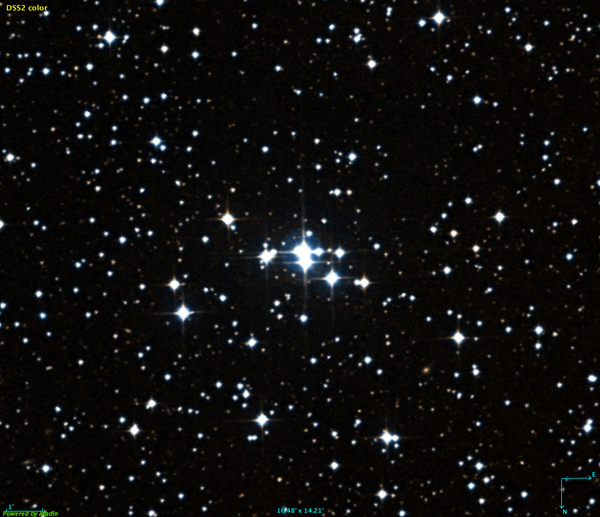NGC 2245 and Herschel 1 in Monoceros
January 2023 - Nebula and Cluster of the Month
I would like to start by wishing you a very happy New Year. 2022 was pretty rubbish, and while it might seem optimistic to hope that 2023 will be any better, this is at least the time of year for optimism.
The sky in January continues to be dominated by the bright Winter constellations. Culminating at midnight throughout most of the month, the dim constellation of Monoceros, the Unicorn, will be our focus for this month. If you’re not sure exactly where Monoceros is, it’s to the left of Orion, roughly the area between Sirius and Procyon.
Monoceros, although not visually stunning, is packed with interesting Milky Way objects. We’re going to be looking at two of the smaller objects this month, although technically, our second object is marginally over the border in Canis Minor.
Firstly, a reflection nebula, NGC 2245, situated in the northwest corner of the constellation, close to the borders with Orion to the west and Gemini to the north, 9½° ENE of Betelgeuse. It lies in a field wreathed in faint nebulosity punctuated with small bright sections like itself. It was discovered by William Herschel on 16 January 1784. He described it as Pretty bright. Much like a star with an electrical brush.
He placed it in his catalogue of planetary nebulae as number 3.

Although it must be made absolutely clear that Herschel was the first person to use the term ‘planetary nebula’, and so would be entitled to use the term to describe whatever he wanted, he ascribed no physical properties to it, beyond stars with burs, with milky chevelure, with short rays, remarkable shapes, etc.
It was simply a useful tag for certain objects that looked similar to each other. This idea of a ‘brushed star’ is typical.
The term ‘planetary nebula’ is now defined much more scientifically. Of the 79 objects in Herschel’s class IV – planetary nebulae, only 20 fall within the modern definition.
NGC 2245 is in actuality a reflection nebula. It is small, 5’x4’. At its heart lies a 10.4(var) magnitude star. The star is variable and bears the designation V699 Mon. It is an Orion-type variable of spectral type A or B and varies between magnitudes 10.3 and 10.8.
The region more-or-less defined by the three bright nebulae NGC 2245, NGC 2247 and IC 446 contains the Monoceros R1 association, a region of young stellar objects (YSOs). Supersonic outflows from YSOs collide with the interstellar material and produce shocked excitation zones known as Herbig-Haro (HH) objects. Mon R1 contains at least 30 YSOs, and many HH objects, 20 of which were discovered by a survey conducted with the 1m Schmidt telescope at Byurakan Observatory in 2020.1
I observed NGC 2245 with my trusty 12” (300mm) reflector in December 2015. My observation is reproduced below.

The description reads ‘A small, bright nebula around a tenth-magnitude star, stretching away from it like a short cometary tail.’ In fact, NGC 2245 is a representative of a type of reflection nebula called ‘cometary nebulae’ because of their resemblance to comets.
Our next object is a little-known open cluster bearing the unusual designation of Herschel 1. I first came across this object when scanning the Catalogue of Optically Visible Open Clusters. OVOC 578 is listed with the alternative designation of Herschel 1, but no other.

Initially, I thought that this object must have been discovered by an astronomer (maybe an amateur) whose name just happened to be Herschel. On digging a little deeper, I found that the discoverer was in fact John Herschel (the famous one). He discovered it in 1827 but for some reason, it didn’t make it into his own catalogues. He first alluded to its existence in a very brief mention in a paper published in 1871. Such scant fanfare meant that the object was subsequently never picked up for inclusion in the NGC.
In Archinal & Hynes, it is listed as ADS 6866 cl, which simply means a cluster associated with double star ADS 6866 (also known as Σ1141). This double star (actually a triple) was discovered by Herschel at the same time as he first saw the cluster. Receiving the same neglect as the cluster, it was rediscovered and subsequently catalogued by Struve, hence his credit as its discoverer.
The upshot of all this is that here is a little open cluster that should have been in the NGC but very few people have ever heard of.
I have looked at the proper motions available to me in this area. At least seven stars across an area of about 13’ square have very similar motions, a strong indicator of physical association. At the centre of this is a small group of five brighter stars, four of which (including the bright double star) share a common proper motion. There is a high likelihood, therefore, that this is a real cluster.
Intrigued by this object, I observed it in January 2017 with my 12” reflector. Although I made no drawing, I did make a written observation of it. I found a tight little group of nine or ten stars dominated by a fairly bright double star, which I later found to be Σ1141.
Whilst very few people have heard of this little open cluster, even fewer have actually seen it. Go on, join them!
| Object | RA | Dec | Type | Magnitude |
|---|---|---|---|---|
| NGC 2245 | 06h 32’ 41” | +10° 09’ 24” | Reflection nebula | - |
| Herschel 1 | 07h 47’ 02” | +00° 01’ 00” | Open cluster | Br * = 8.4 |
References:
- New Herbig-Haro objects and outflows in the Mon R1 association, T. A. Movsessian, T Yu Magakian, S. N. Dodonov. Mon. Not. R. Astron. Soc. 500 (2), 2440-2450 (2021)